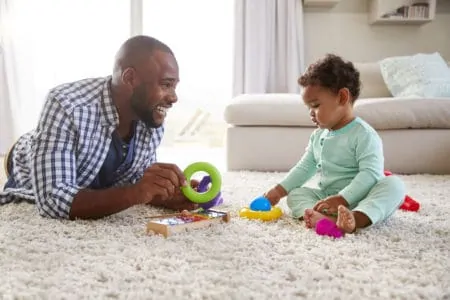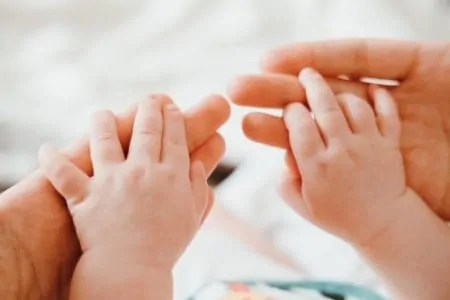Toddlers come in all shapes and sizes, which makes it tricky to know if your little one is following a healthy path regarding their height and weight.
If your child looks bigger or smaller than others at the playground, it is easy to worry that something is wrong. We have been there; our oldest was a giant compared to peers, while our youngest barely stayed on the chart. If we knew then what we know now about toddler growth charts and percentiles, we would have saved ourselves a lot of stress.
We want to save you from those sleepless nights. Here is our parent-to-parent guide to toddler growth, decoding the charts, and knowing when to call the doctor.
Key Takeaways
- Toddlers grow at unique rates, so comparing your child to peers often causes unnecessary anxiety.
- Growth charts are tools to track trends over time rather than judging a single measurement.
- Genetics, nutrition, and overall health play the biggest roles in your child’s size.
- Consult a pediatrician if you notice a sudden, drastic drop or spike in your child’s growth curve.
How Your Child Grows
The average, full-term baby will roughly double their birth weight in the first four months. After that sprint, growth slows down slightly. By the first birthday, a baby’s weight usually triples, and their length increases by about 50 percent.
During the second year, the pace settles into a steady jog. The average toddler gains about 8 pounds and grows 4 to 5 inches. In the third year, growth tapers further to around 4 pounds and 2 to 3 inches over 12 months.
| Age | Size | Girls | Boys |
| 12 months | Height | 29 inches (74 cm) | 30 inches (75.7 cm) |
| 12 months | Weight | 19 lbs 10 oz (8.9 kg) | 21 lbs 3 oz (9.6 kg) |
| 15 months | Height | 30 ½ inches (77.5 cm) | 31 inches (79.1 cm) |
| 15 months | Weight | 21 lbs 3 oz (9.6 kg) | 22 lbs 11 oz (10.3 kg) |
| 18 months | Height | 31 ¾ inches (80.7 cm) | 32 ½ inches (82.3 cm) |
| 18 months | Weight | 22 lbs 8 oz (10.2 kg) | 24 lbs 1 oz (10.9 kg) |
| 21 months | Height | 33 inches (83.7 cm) | 33 ½ inches (85.1 cm) |
| 21 months | Weight | 24 lbs 1 oz (10.9 kg) | 25 lbs 6oz (11.5 kg) |
| 2 Years | Height | 2 ft 10 inches (86.2 cm) | 2 ft 11 inches (87.7 cm) |
| 2 Years | Weight | 26 lbs 11 oz (12.1 kg) | 28 lbs (12.7 kg) |
| 2 ½ Years | Height | 3 ft (92.1cm) | 3 ft (92.1cm) |
| 2 ½ Years | Weight | 28 lbs 11oz (13 kg) | 30 lbs (13.6 kg) |
| 3 Years | Height | 3 ft 1 inches (94.2 cm) | 3 ft 2 inches (95.3 cm) |
| 3 Years | Weight | 30 lbs 10 oz (13.9 kg) | 31lbs 12oz (14.4 kg) |
| 3 ½ Years | Height | 3 ft 2 inches (97.6 cm) | 3 ft 3 inches (99 cm) |
| 3 ½ Years | Weight | 32 lbs 14 oz (14.9 kg) | 32 lbs 12 oz (15.3 kg) |
| 4 Years | Height | 3 ft 4 inches (101.6 cm) | 3 ft 4 inches (101.6 cm) |
| 4 Years | Weight | 35 lbs 1 oz (15.9 kg) | 35 lbs 15 oz (16.3 kg) |
Decoding Growth Chart Percentiles
Growth charts utilize lines labeled as percentiles to show how a baby’s weight and height compare to other children of the same age and gender.
Think of it this way: If your child falls in the 75th percentile, they are bigger than 75 percent of children their age, while 25 percent of children are larger.
Each line follows roughly the same curve but sits at different levels on the chart. Plotting your child’s measurements allows you to see if your little one is growing at a consistent rate over time. This trend is far more important than any single measurement on a specific day.
While most babies are tracked on standard charts, specific charts exist for premature babies and those with medical conditions like Down syndrome to ensure accurate monitoring.
The CDC updated these charts in 2000 to be more representative of the entire US population, moving away from older data that focused predominantly on formula-fed, Caucasian infants (1).
Why Is My Toddler Bigger or Smaller?
Many factors contribute to your child’s size relative to their peers. It is rarely just about how much they eat (2).
Here are common influencers on toddler growth:
Genetics
Look back a couple of generations to see if your child inherited their taller or shorter stature. Our youngest son barely hit the fifth percentile, even though we are taller than average. A quick look at the family tree revealed his paternal grandfather was just 4’10” in adulthood, and it turns out our son inherited those genes.
Nutritional Intake
Children who do not consume enough food, or lack food with appropriate nutritional value, may lag behind peers. If the body does not get the necessary calories and vitamins, it prioritizes organ function over growth spurts.
Hormonal Balance
Growth is moderated by hormones. In rare cases, a child may produce too much or too little growth hormone. Too much causes rapid growth, while a deficiency can result in a child falling behind on the charts.
Thyroid Function
The thyroid releases chemicals that moderate bone growth. If a child has hypothyroidism, their body does not produce enough of these hormones, preventing them from growing at the expected pace.
Chronic Illness
Children living with chronic health conditions may fail to grow at the average rate. The illness might affect nutrient absorption, or the body may burn extra calories fighting the condition rather than using them for growth.
Failure to Thrive
“Failure to thrive” is a general medical term for a child who does not grow at the expected rate (3). The causes vary widely, ranging from digestive issues to food intolerances, and sometimes no specific cause is ever identified.
Is Weight Loss Normal?
Toddlers may lose weight when sick but typically regain it quickly (4). It is also common for toddlers to “lean out” as they start walking and running. They might get taller without gaining much weight, making them look thinner.
However, consult your doctor if your toddler loses weight without illness, doesn’t regain weight after being sick, or seems lethargic.
Red Flags: When to Consult a Doctor
There is generally no need to worry about where your child starts on the chart. Whether they are in the 5th or 95th percentile, as long as they follow their own curve, they are likely healthy.
Concerns arise when lines cross dramatically. For example, if your child tracks steadily at the 75th percentile for two years and suddenly drops to the 25th, that is a red flag. Similarly, a jump from the 5th to the 50th in a short time warrants a check-up.
If you notice these drastic shifts, or if weight gain stalls completely for several months, speak with your pediatrician.
Managing Toddler Weight Healthily
If your toddler is following their growth curve, they likely do not need to lose weight. While some doctors check BMI (Body Mass Index), research suggests it can be unreliable for children under nine (5).
Avoid strict Diets
Putting a toddler on a diet or labeling foods as “bad” can trigger lifelong issues with food and body image. Restricting calories for a growing brain and body is rarely the right answer unless supervised by a specialist.
Instead of focusing on weight loss, aim to keep their weight stable as they grow taller. This allows them to “grow into” their weight naturally.
Adopt the Division of Responsibility
The best approach to toddler eating is the “Division of Responsibility.” Your job is to provide healthy options at set times; their job is to decide what and how much to eat.
Involve them in meal planning and grocery shopping. When children feel they have input, they are less likely to fight you at the dinner table.
Make Changes Slowly
Don’t overhaul the pantry overnight. Toddlers find comfort in routine, and a sudden change in eating habits can cause anxiety. Introduce new, nutrient-dense foods alongside their favorites to keep the peace.
Prioritize Active Play
Encourage movement naturally. You do not need formal sports or exercise routines. Simply walking to the park, having a dance party in the living room, or building an obstacle course gets their heart rate up.
FAQs
Try Not to Worry
We know it is easier said than done, but try not to obsess over the numbers. Unless your child is significantly off the charts or their growth curve changes abruptly, there is likely nothing to worry about.
If you have a gut feeling that something is off, speak to your doctor before changing their diet. It is best to rule out medical causes first and proceed with professional guidance.






